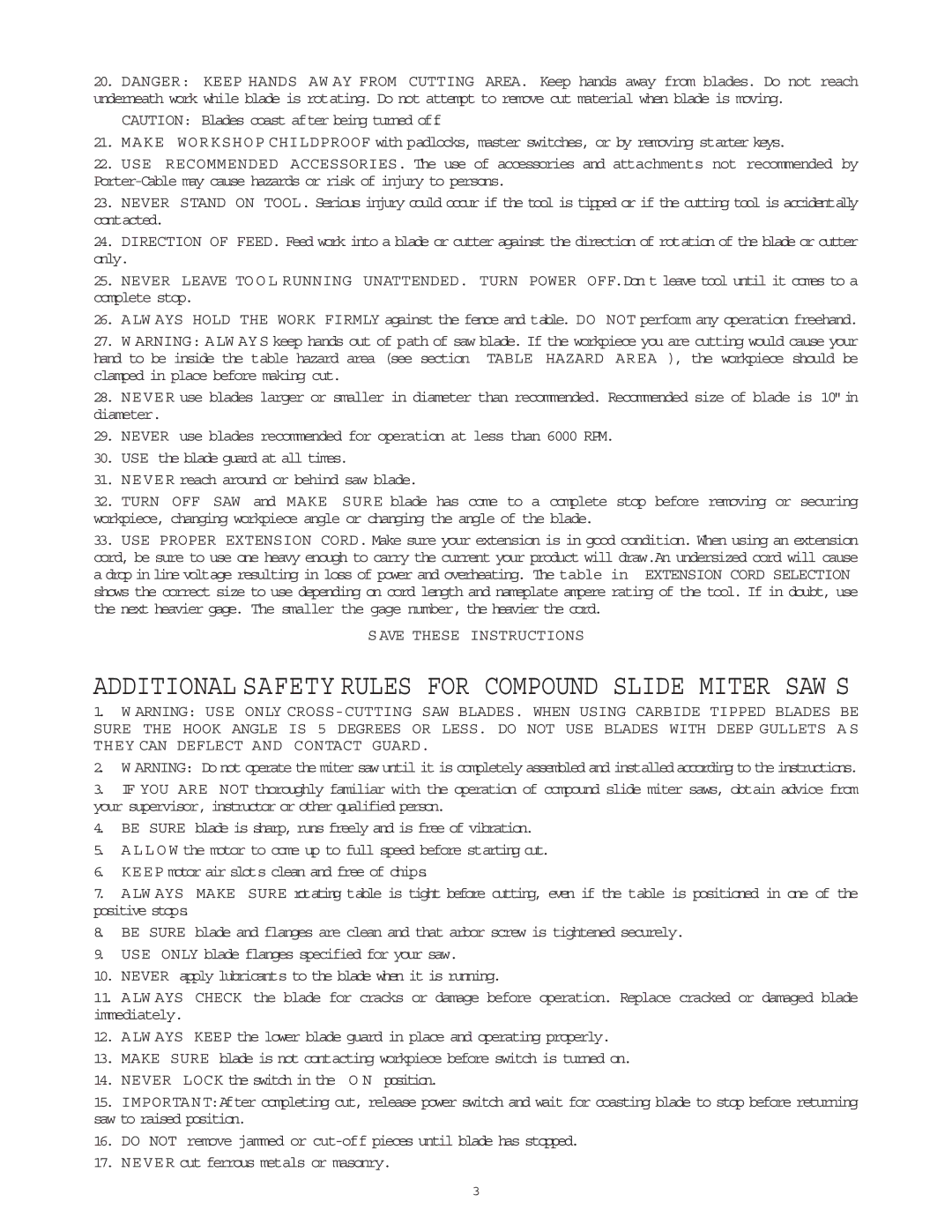20.DANGER: KEEP HANDS AW AY FROM CUTTING AREA. Keep hands away from blades. Do not reach underneath work while blade is rotating. Do not attempt to remove cut material when blade is moving.
CAUTION: Blades coast after being turned off.
21. MAKE WORKSHOP CHILDPROOF with padlocks, master switches, or by removing starter keys.
22.USE RECOMMENDED ACCESSORIES. The use of accessories and attachments not recommended by
23.NEVER STAND ON TOOL. Serious injury could occur if the tool is tipped or if the cutting tool is accidentally contacted.
24.DIRECTION OF FEED. Feed work into a blade or cutter against the direction of rotation of the blade or cutter only.
25. NEVER LEAVE TO O L RUNNING UNATTENDED. TURN POWER OFF.Don t leave tool until it comes to a complete stop.
26.ALW AYS HOLD THE WORK FIRMLY against the fence and table. DO NOT perform any operation freehand.
27.W ARNING: ALW AYS keep hands out of path of saw blade. If the workpiece you are cutting would cause your hand to be inside the table hazard area (see section TABLE HAZARD AREA ), the workpiece should be clamped in place before making cut.
28.NEVER use blades larger or smaller in diameter than recommended. Recommended size of blade is 10" in diameter.
29.NEVER use blades recommended for operation at less than 6000 RPM.
30.USE the blade guard at all times.
31.NEVER reach around or behind saw blade.
32.TURN OFF SAW and MAKE SURE blade has come to a complete stop before removing or securing workpiece, changing workpiece angle or changing the angle of the blade.
33.USE PROPER EXTENSION CORD. Make sure your extension is in good condition. When using an extension cord, be sure to use one heavy enough to carry the current your product will draw.An undersized cord will cause
a drop in line voltage resulting in loss of power and overheating. The table in EXTENSION CORD SELECTION shows the correct size to use depending on cord length and nameplate ampere rating of the tool. If in doubt, use the next heavier gage. The smaller the gage number, the heavier the cord.
SAVE THESE INSTRUCTIONS
ADDITIONAL SAFETY RULES FOR COMPOUND SLIDE MITER SAW S
1. W ARNING: USE ONLY
2.W ARNING: Do not operate the miter saw until it is completely assembled and installed according to the instructions.
3.IF YOU ARE NOT thoroughly familiar with the operation of compound slide miter saws, obtain advice from your supervisor, instructor or other qualified person.
4.BE SURE blade is sharp, runs freely and is free of vibration.
5.A L L O W the motor to come up to full speed before starting cut.
6.KEEP motor air slots clean and free of chips.
7. ALW AYS MAKE SURE rotating table is tight before cutting, even if the table is positioned in one of the positive stops.
8.BE SURE blade and flanges are clean and that arbor screw is tightened securely.
9.USE ONLY blade flanges specified for your saw.
10.NEVER apply lubricants to the blade when it is running.
11.ALW AYS CHECK the blade for cracks or damage before operation. Replace cracked or damaged blade immediately.
12.ALW AYS KEEP the lower blade guard in place and operating properly.
13.MAKE SURE blade is not contacting workpiece before switch is turned on.
14.NEVER LOCK the switch in the O N position.
15.IMPORTANT:After completing cut, release power switch and wait for coasting blade to stop before returning saw to raised position.
16.DO NOT remove jammed or
17.NEVER cut ferrous metals or masonry.
3
